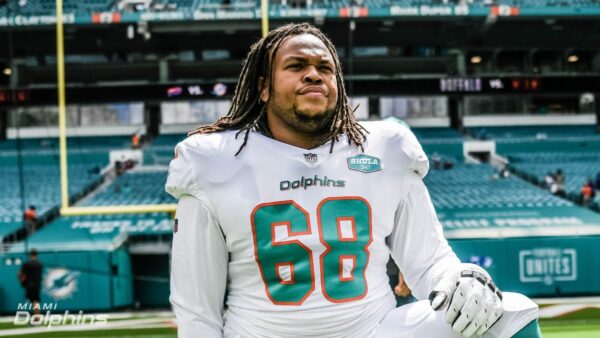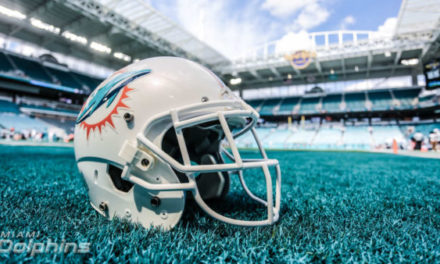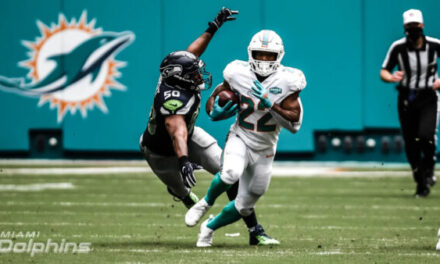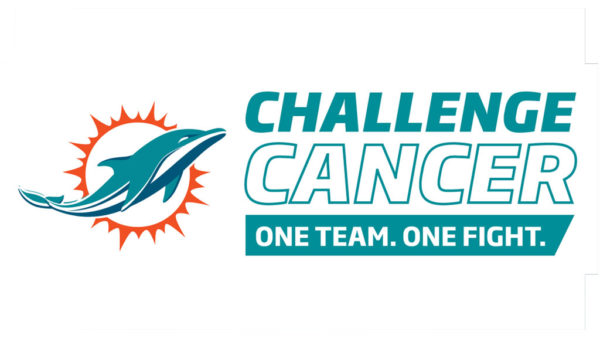

On the eve of the Dolphins trading for former-Panther’s 2nd-round tackle, Greg Little, I thought I’d share a hypothesis I had in the shower yesterday:
With how much we have invested into our offensive line, it would be a franchise-breaker for it still to be our Achilles heel in a year’s time.
Though nearly the very next play, the cracks started to form as every time Tua handed the ball to Malcolm Brown, the entire line seemed to slip on nonexistent banana peels – forcing Brown to finish the game with a lackluster 9 carries for 8 yards (a 0.9 yards per carry average).
This issue seemingly intensifies when mixed with every beat writer, dubbing our offensive line as the start of the football apocalypse:
From PM: A look at the Dolphins' offensive line issues (this is a 20-year recording) and other problems. And Flores weighs in: https://t.co/uco2A3N0kY
— Barry Jackson (@flasportsbuzz) August 16, 2021
NEW: Dolphins offensive play caller still unknown, but needed offensive line improvements aren't https://t.co/mWNEeSFklB
— Joe Schad (@schadjoe) August 15, 2021
Why is it, no matter who the Dolphins sign or draft, the line still seems to fold in week 12 to Buffalo?
And, based on our draft assets used for the positional unit, shouldn’t our line soon be dominant?
(What a terrific segway, Carter!)
To answer this question, I went into the lab to determine how much ‘draft capital’ we have actually spent on offensive line assets since 2019 (the year we drafted our starting center, Michael Deiter).
I set out to answer one major question:
Compared to the rest of the league, how much ‘draft capital’ has Miami used on offensive line help between 2019 and 2021?
[pickup_prop id=”5263″]
The Research Method
I first wanted to find out how to accurately define the phrase ‘draft capital.’ Lucky for me, many reputable websites have compiled draft value charts that teams often use for draft information and trades.
These charts start at ‘3000’ for the first overall pick and move south from there:
2021 Draft Value Chart:
- Jaguars – 3000 – Trevor Lawrence
- Jets – 2600 – Zach Wilson
- 49ers – 2200 – Trey Lance
- Falcons – 1800 – Kyle Pitts
- Bengals – 1700 – JaMarr Chase
- Dolphins – 1600 – Jaylen Waddle
So, for example, the Dolphins spent ‘1600’ draft capital on wide receivers in the 2021 Draft.
Now, here is where it gets tedious. I was then tasked to compile each and every offensive-line-related draft selection in the first 3 rounds by every NFL team over those last 3 years (2019-2021) and compare it to the draft value chart I had found.
Using this data, I was able to create these leaderboards:
The Results
*As a prelude to these results, I want to emphasize that I wouldn’t have written this article unless the numbers had backed up my hypothesis.*
Let’s start with the leaderboards for which team drafted the most players in those first 3 rounds:
| NFL Rank | Team | # of Players | Rounds (1st, 2nd, 3rd) |
| T1 | Dolphins | 4 | 1,2,1 |
| T1 | Falcons | 4 | 1,1,2 |
| T3 | Jets | 3 | 2,0,1 |
| T3 | Vikings | 3 | 2,1,0 |
| T3 | Broncos | 3 | 0,1,2 |
| T3 | Titans | 3 | 0,2,1 |
Now, let’s move on to the juicy data:
| NFL Rank | Team | ‘Draft Capital’ Used |
| 1 | Jets | 2482 |
| 2 | Falcons | 2150 |
| 3 | Dolphins | 2090 |
| 4 | Vikings | 1980 |
| 5 | Lions | 1770 |
Dolphins Selections (2019-2021):
| Year – Selection | Player Drafted |
| 2019 – 78 overall | Mike Deiter |
| 2020 – 18 overall | Austin Jackson |
| 2020 – 39 overall | Robert Hunt |
| 2021 – 42 overall | Liam Eichenberg |
Analyzing the Results
Here is what we have learned:
- Out of all 32-teams in the league, Miami has drafted the most offensive lineman (in the first 3 rounds) in the last 3 years.
- Miami has spent the 3rd most ‘draft capital’ on offensive lineman over that same span.
Now, what does this all mean?
Theoretically, if the Dolphins have drafted well, they should have a fully solidified line by next year. But, at the moment, that outcome seems far-fetched – as I can’t think of even one lineman from those drafts that I’m currently comfortable giving a long-term contract to.
That being said, it’s not yet time to panic. Austin Jackson, Robert Hunt, and Liam Eichenberg still have a ton of time to develop enough to justify the team’s investments in them.
In Conclusion
Based on the team’s ample investments in this area, the o-line unit should be one of its’ best by next year.
I pray it is.














You’re completely off base. Grier has shown an inability or unwillingness to address the the OL or RB position when it is a glaring weakness. You can’t teach an old dog new tricks. You can dream, but I will live in reality.
We’ve had a problem finding run blocking OL for years. And these draft picks seem to be no exception. Austin Jackson has been trending towards RT or backup. He seems fast enough, but something is off. In general, small speedy guys are better run blockers and big brutes tend to hold up better in the passing game. These guys seem good enough to pass block; it would be nice if we could find a probowler.
Dieter is a small speedy guy; he could turn out better than advertised.